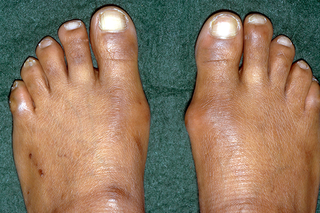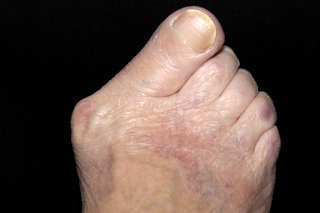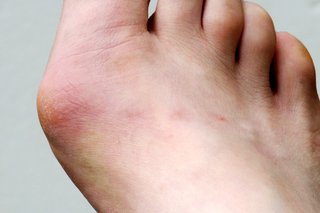A bunion is a bony lump or deformity that forms on the side of the big toe. It happens when the joint of the big toe grows sideways. This pushes the bones of the big toe towards the smaller toes.
Bunions can cause pain. There are ways to ease the pain but only surgery can remove the bunion and correct the deformity.
Check if you have a bunion



You may also have pain along the side or bottom of your feet. This is usually worse when wearing shoes and walking.
If you're not sure it's a bunion
A bunion can have similar symptoms to:
- gout - red, hot, swollen skin over the affected joint and pain that comes and goes
- arthritis - aching, swollen and stiff joints that usually feel worse in the morning
- broken toe - pain, bruising and swelling after hurting your toe
Non-urgent advice: Speak to a GP if:
- you are not sure it's a bunion
How you can ease bunion pain
You cannot get rid of bunions yourself or stop them getting worse.
But there are things you can do to relieve pain.
Do
-
wear wide shoes with a low heel
-
hold an ice pack or a bag of frozen peas wrapped in a tea towel to the bunion for up to 5 minutes at a time
-
try bunion pads - you can get these in pharmacies to stop your bunion rubbing against your shoes
-
ask your pharmacist about medicines that can help
-
take paracetamol or ibuprofen
-
stretch your calf muscles
-
try to lose weight if you're overweight
-
avoid wearing high heels, or tight pointy shoes
Non-urgent advice: Speak to a GP if:
- the pain has not improved after trying home treatments for a few weeks
- the pain is stopping you doing your normal activities
- your bunions are getting worse
- you also have diabetes - foot problems can be more serious
Treatments from a GP or podiatrist
A GP or podiatrist can tell you:
- what you can do to ease your symptoms
- how to reduce bunion pain using insoles, toe spacers and toe supports
Surgery for bunions
A GP may refer you to a surgeon if your bunion is very painful or is having a big effect on your life.
Surgery is not done just to improve how your feet look.
Surgery is the only way to remove a bunion and correct any deformity.
How surgery is done
The most common operation for bunions is an osteotomy.
An osteotomy involves:
- Making a small cut in the skin over your big toe.
- Cutting or scraping away the bunion.
- Straightening your toe bone.
- Fixing your toe bone in place with metal screws or staples put under your skin. These are often left in permanently.
Surgery is usually done when you're asleep under general anaesthetic.
Most people go home the same day.
It can take a while to recover from surgery.
You'll usually need to:
- stay off your feet as much as possible for at least 2 weeks
- avoid driving for 6 to 8 weeks
- stay off work for 6 to 12 weeks
- avoid sports for up to 6 months
After surgery:
- your toes might be weaker or stiffer than before
- your toes may not be perfectly straight
- your feet might still be slightly wide, so you may still need wide-fitting shoes
Bunions sometimes come back after surgery.
